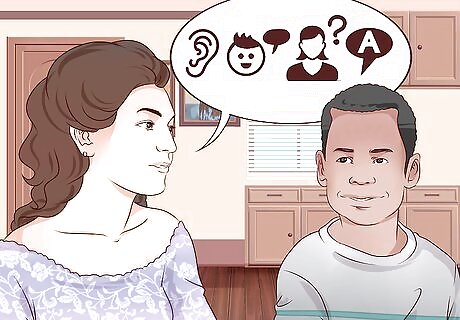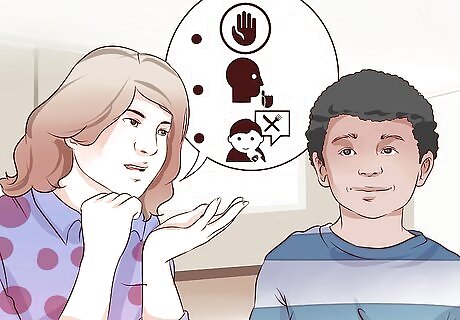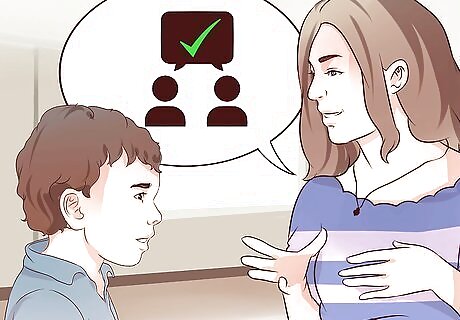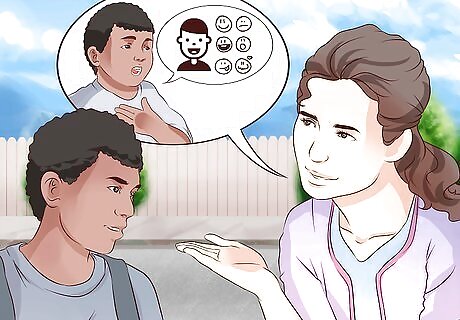
views
X
Expert Source
Iddo DeVries, MA-SLPSpeech-Language Pathologist
Expert Interview. 28 August 2020.
Teaching Scripts

Know the purpose of scripts. Autistic children may rely upon scripts to make communication easier. Many autistic children repeat words and phrases (echolalia) as a way to say, “I heard what you said and am thinking about the answer.” Try to remain calm and patient while interacting with the child. If you think about the fact that echolalia serves a communication purpose for the child, and it’s not just way to try and frustrate people, it can help you to see it from the child’s point of view.

Teach the “I don’t know” script. For those questions to which they do not know the answer, autistic children should be encouraged to say “I don’t know”. There is evidence to suggest that training a child to use “I don’t know” to respond to questions to which they don't know the answer helps in picking up and using this new phrase appropriately. Try asking a series of questions to the child that you know they don't know the answer to. For example, ask "Where are your friends?" and prompt the answer by saying, “I don’t know.” Then, “What is the capital of Kansas?” followed by, “I don’t know.” You can write down many questions ahead of time and practice this script each time. Another way to teach the “I don’t know” script is by having another person there who answers the unknown questions with “I don’t know.”

Prompt the child to give the correct response. Children may use echolalia when they don't know how to respond, or how to turn their thoughts into appropriate words. Providing a script helps them know what to say. For example, ask "What is your name?" and prompt the correct response (the child’s name). Repeat this until he has learned the right script. Try this with all questions that have the same answer. “What color is our house?” followed by “Brown.” And, “What is our dog’s name?” followed by “Spot.” It’s important that you supply the answers every time to teach the script until the child starts doing it on his own. This approach only works for questions that always have the same answer. For example, it would not work for "What color is your shirt?" because the child's shirt color will change each day.

Teach your child plenty of scripts. This way, your child can successfully communicate basic things, even when feeling overwhelmed. This gradual process can provide the tools to build confidence, vocabulary, communication and proper interaction for the child.

Teach scripts that focus on needs. If an autistic child cannot communicate their needs, they may become frustrated or distressed, and melt down. Scripts will help them tell you what they need, allowing you to fix the problem before they are pushed over the tipping point and start screaming or crying. Example scripts include: I need quiet time. I'm hungry. That's too loud. Please stop.
Using the Modeling Technique

Use the exact words you want the child to use. Modelling should include the exact words and phrases which the child can understand, pick up and reproduce. This helps them learn how to phrase the things they want to say. For example: you already know that the child dislikes playing with a certain toy, but in order to teach them to express it verbally, you can offer the toy and then keep using phrases or words such as "no thank you," or "I don't want to." When the child uses the desired phrase, give the desired outcome. For example, if the child successfully says "I want more please," then give them more. If you repeat the phrase several times and the child does not respond, do the desired action. The child will start associating the phrase with the action. Then try again later. In time, the child will start using the phrase.

Leave a blank in your sentences and point to the answer. If you intend to give your child a snack or if it is time for the child to drink the milk, then you could model by saying “I want to drink ____ (point to the milk and say “milk”). Or say, “I would like a ____” (point to the snack and say “snack”). In time, the child will fill in the blank by themselves.

Say statements to your child, rather than asking questions. It is best to avoid questions such as “Do you want this?” or “Do you want help?” because they will repeat the questions. Instead, say what they should say. For example: if you see them trying to reach something, instead of asking “Do you want me to help you?” try saying, “Help me reach my toy, please,” or “Please lift me up so I can reach my book.” Encourage them to repeat the phrase. Then, whether the child repeats it or not, help them.

Avoid saying the child’s name at the end of phrases. The child will start repeating it after you and it won’t make sense. When saying “Hi!” or “Goodnight!” simply say the word and don’t say their name after it. Or, you can say their name first and then pause and say what you intend to say last. When the child needs to be commended for a job well done, then instead of using the name of the child, use the congratulatory word alone. Instead of “Great job Alex!” just say “Great job!” or show it through actions in the form of kisses, a pat on the back, or a hug.

Keep teaching fun and lighthearted. Choose a time when you are both relaxed, and be willing to make it silly or turn it into a game. This will help the child look forward to learning, and it will give the two of you an opportunity to connect and have fun. Teaching should not be painful, nor should it involve a battle of the wills. If one or both of you are getting too frustrated, stop and try again later.
Understanding the Communication Purposes of Echolalia

Learn about the ways echolalia can be used to communicate. Echolalia has many uses as a form of communication. Autistic children may use it for... Learning language: If they don't know the meaning of individual words or the purposes or uses of questions. In these cases, children rely on phrases that they've heard to communicate. For example, saying "Do you want a cookie?" instead of “Can I have a cookie?” because in the past when an adult said the first question, a cookie materialized. Saying yes: Sometimes autistic people say "yes" by repeating the last part of the question. For example, if you ask your daughter "Do you want to go home?" and she says "want to go home," she is probably trying to say she does want to go. Communicating when stressed or startled: Echolalia is easier than spontaneous speech, which makes it easier to use during stress. For example, an autistic in a crowded room might be struggling to process all the noise and movement around them, so forming complete/original sentences might be too much. Expressing feelings: If they feel the same way they felt another time when a statement was used. Echolalia can communicate feelings. For example, the child may say, "The pool is closed today" to express any type of disappointment, because there was one time that the pool was closed and he was disappointed. Indicating processing time: Echolalia may be a polite way to show that they heard you and are thinking. For example, when asked what they want for supper, an autistic person might ask themselves "What do I want for supper?" This gives them time to think without making you think they're ignoring you. Connecting: Echolalia may be used as games or jokes.Tip: If you're not sure what the child is trying to communicate, you can ask "What do you mean?" or just wait quietly while they work on turning thoughts into words. If they're really stuck, try saying "show me."

Remember that delayed echolalia may be used outside of social interaction. While some people mistake echolalia for "meaningless" behavior, there's always a reason. Echolalia can help autistic people in several ways: Remembering things: Autistic children may have trouble keeping track of a series of steps. They may repeat the sequence to themselves as they work, to help them remember and assure themselves that they are doing it correctly. For example: "Get a cup. Pour your juice slowly. Not too fast. Put the cap back on. Good job." Calming down: Repeating a reassuring phrase can help autistic children regulate their emotions and relax. Stimming: Vocal stimming may help with a number of things: concentration, self-control, and elevating mood. If the child is disrupting others, you may ask for them to turn down the volume, but it's usually best to let them enjoy themselves.

Notice when your child uses echolalia. This will help you discern its purpose. See if context clues or habits can help you understand what your child is trying to do. A child who uses echolalia before a meltdown probably is using it to try to calm down when they feel overwhelmed. A child who repeats your question (e.g. "Do you want a cookie?" to express wanting a cookie) may not understand individual words. They may be trying to say "yes," or they may just think this is a fun game. A child who repeats phrases to themselves in a singsong voice is probably using it for concentration or enjoyment.
Supporting Communication

Handle any frustrations on your end. It's not easy when you see your child struggling to communicate, and sometimes it's frustrating if they're often repeating things when you'd like quiet time. Remember that the child is trying to communicate when doing this. They simply don't have the same language skills that you do yet. Take deep breaths. If you need to, go into a different room for a little while if you get very frustrated and take some deep breaths and collect your thoughts. Remember that the child is probably frustrated too. (They certainly aren't having meltdowns for the fun of it.) Take care of yourself. Parenting can be exhausting sometimes, and there’s nothing wrong with admitting that. Take baths, practice yoga, allow yourself time with other adults, and consider joining a community group of parents or caregivers of autistic/disabled children.

Talk to them. Kids learn language skills by listening to others. Speak to your child, even if they don't show an obvious response. They might start responding someday. Treating them like they're intelligent can make a big difference. Remember that behavior can be communication. For example, if you say "Did you have a good day at school today?" and your child grins, coos, and flaps their hands, then you have your answer! Some parents fall into the trap of thinking a nonspeaking or thoughtful autistic child isn't listening to them. In reality, your child can probably hear and understand you just fine.

Show empathy when your child is struggling to communicate. Turning thoughts into spoken words can be challenging for some autistic kids. While you can't always fix it, you can show them that you care. Try saying "I don't know what you mean right now, but I care what you have to say."

Teach your child to communicate a "yes" or "no" nonverbally. This can be handy when they are struggling with words. Try to figure out in words what they are trying to say. Then, ask them to confirm it. This can reduce misunderstandings and frustration. Teach them to give you a thumbs up or thumbs down. If they forget, prompt them by showing a thumbs up or thumbs down with your hand. Try saying "Is that right? If so, give me a high five." If they hit or tap your hand, you'll know that you understood them correctly. Show them two hands. "Label" each hand with an option, like "Touch this hand if you want to go home and this one if you want to stay." Let them choose what to touch.

Consider augmentative and alternative communication (AAC) for a child who has limited communication skills. The right form of AAC can reduce frustration (for both you and your child) by helping them communicate while they learn to speak more easily. A good speech and language pathologist (SLP) can help your child learn to use AAC. If your child can speak normally most of the time but struggles when overwhelmed, a form of AAC may help for when they're having a tough time.

Praise assertive communication. Learning to communicate can be a challenge, and it helps when you recognize the child's efforts. A little praise can help reinforce those skills and help the child feel good about themselves. "Great job telling me how you feel, Emerson! Thank you for letting me know you're sad. What do you think would help you feel better?" "Thanks for telling me it's too loud in here. Do you want a break?" "Great job with thumbs up/thumbs down! You're getting very good at that."

Stay patient and give your child time. If autistic children don't feel pressured to respond immediately, they can feel more relaxed and use language better. Be patient and make it clear that you're happy to hear what they have to say, no matter how long it takes for them to say it. Allow pauses in the conversation for your child to think. Forming a coherent response may take a lot of cognitive energy for them.




















Comments
0 comment